Hockey drills for technique hitting
- At a high level, the drag flick is a common variant of the penalty corner.
- It is also the only variant where the ball can be played at high speed, high on the goal.
- Below, the basic technique of the sledge push is explained in 4 steps.
- The backhand stroke is useful for a shot on goal but also to pass to your teammate.
- With the backhand, you place your left hand at the end of your stick and your right hand slightly above the middle of your grip.
- Usually you play a backhand from the barrel.
- When your right foot is in front you let the ball roll a little bit.
- Meanwhile you turn your stick to the backhand, you bend your right knee and then you hit the ball with the part of your stick just above the curl (make sure the ball doesn't stick in the curl otherwise you have no control over it).
- You can make the ball go low or high by turning your stick.
- With a diagonal stick the ball flies upwards, with a straight stick it stays on the ground.
- Player 1 plays the ball to player 2 and player 1 runs on
- Player 2 bounces the ball back to player 1,
- Player 1 lines up the ball between the pawns (the player himself will not run in the "pawn box".
- Player 1 finishes the ball on goal.
- Player 1 runs with the ball to the head circle and hits the goal
- Player 4 plays the ball to the left where player 2 and defender 1 come running in (2v1)
- Player 4 plays the ball to the right where player 3 and defender 2 come running in (3v2)
- Player 4 runs with a ball into the circle and plays off the attack (4v2)
- Float along the outside of the square.
- Not only looking at the ball but also looking forward/around you.
- Orange 1 passes to Blue 2.
- Blue 2, 3, 4 try to score in the 2 little goals on the back line.
- Orange 1 tries to get in possession of the ball by defending on its strong side (fh). If he succeeds, he can score in the goal on the middle line (1½ meter wide).
- The exercise is started again when:
- Blue scores in 1 of the 2 goals on the back line at Orange.
- Orange 1 scores in the conversion in the goal of Blue.
- The ball goes over the back line.
Tips Ball possession
- Threaten with the ball and speed towards the goal.
- Look at each other as attackers when offering the ball.
- Help the ball carrier by running away from the ball.
Tips on no ball possession
- Guide with stick on the ground, forehand at ball height.
- Stay out of the ball carrier's physical space.
- Keep the ball on your forehand side. or v2 to create a 1:2 situation (double).
Passing tips
- At loss of possession: Pressure the ball immediately, cut off the shortest path to the goal.
goal.
- When gaining the ball: Keep the ball in quick action/goal attempt towards the goal.
Make it more difficult
- Use 1 goal instead of 2.
- Vary the tackling.
Explanation
3 (4) against 2 + goalkeeper
OrganisationField
: demarcated space (on half a field)
General
- The form starts when blue 1 passes to orange 1.
- Orange 1, 2 and 3 ( possibly 4) try to score in the goal.
- Blue 1 and 2 try, by working together, to take over possession of the ball on their strong side and then to score in one of the little goals on the centre field (circle size about 3 metres).
The form stops when:
- Orange scores in the goal.
- Blue scores in the conversion in one of the little goals on the half way line.
- The ball goes over the back line.
Exceptions:
- Ball over the sideline is a normal strike.
- Foul is a normal free hit.
Tips on ball possession
- Look before taking the ball (pre-scanning) and recognise space.
- Take free hits and hits as quickly as possible.
- Use push passes.
Tips on non-ball possession
- Work together (cover each other's backs), give pressure on the ball, keep the ball on your defensive forehand side (fake space).
- Force a pass to the back or force a pass wide; this is better than a deep pass.
- Make sure you are always between the ball and your own goal
Switching tips
- On losing the ball:
- Keep pressure on the ball straight away
- Get between the ball and your own goal as quickly as possible and help your team-mate
- On winning the ball:
- Look for the free space
- Play a confident pass or accelerate strongly yourself.
- Make it easier
- Vary the method of passing (e.g. push pass) or initial pass to another player.
- Make it more difficult
- Increase Pressure:
- Who scores the most goals in 10 ball starts);
- can Orange 1,2,3 score within 30 sec.
- Increase Pressure:
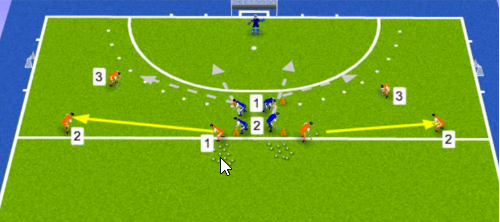
- Two teams with substitutes, substitutions are made when a goal is scored.
- Each person defends a goal, on each field there are 5 goals,
- so there are also 5 people who defend these goals.
- If a goal is scored in your goal, you have to sit on the sidelines and you become a substitute.
- A new player (substitute) from the side enters the field and will defend the goal.
- If a goal is scored, it is 1 point.
- The team that has the most points at the end of the game is the winner.
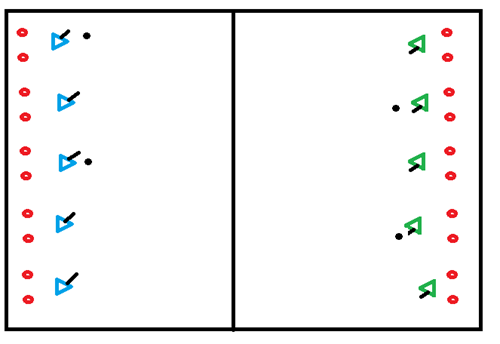
Overplaying to score
- Two players continuously play the ball over
- until one of them is so close to the goal
- that he can score in the goal.
Variation 2-1 situation:
- Under pressure from the defender, the attackers must now play together and try to score.
- The defender can score a point by conquering the ball and then dribbling over the dead ball line.
- This is the short side without a goal.
Purpose
: Various technical forms to warm up.
Format
:The exercise can be set up one-sided or two-sided. This depends on the number of players in the training.
- At point A, the player makes a drag and passes the pawns. Then he passes to the player at point B.
- The player at point B takes the ball and dribbles to point C. From there he passes to the player at point C.
- The player receives the ball and turns towards the goal, completing the pass
- Before turning, you run after the ball. Point D rejoins point A again.
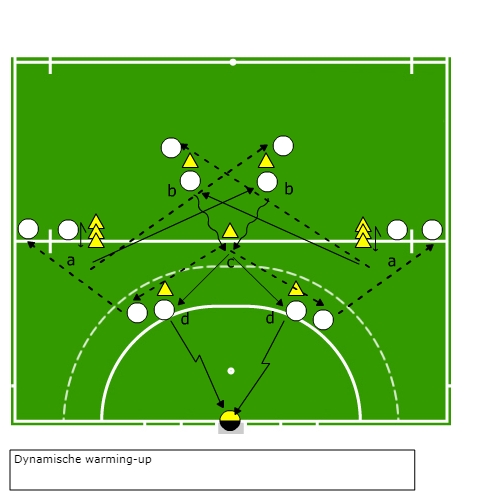
Variations:
- You can set up the exercise single-sided and double-sided.
- You can also choose to warm up the goalkeeper in this way.
- At C, you can switch sides. If you are coming from the right, play the ball to the right, so that you can practise from both sides.
Points of attention:
- This is a good time to look at different techniques of your players and polish them.
- When turning and dribbling, the ball must stay on the stick.
- There is only one point at C, so players should not get in each other's way and look for the next ball to enter play.
- All balls are played into the forehand of the teammates.
Goal
: The goal of this exercise is to actively pass between the ball and the defender, making yourself playable
Set-up
:In order to run this exercise properly, you need a minimum number of players. You can play with this when you make the exercise one station shorter.
- The player at B starts walking and runs with a curve past the orange pawns. By doing so, he offers himself for play.
- The player at A plays into the run-in player and runs around the indicated cones towards point B.
- The player with C runs in a curve around the orange cones. The moment of starting is important. He pays attention to how far the player at point B is.
- The player at point B plays into the player who left from point C.
- The player at point C receives the ball in front of the orange cones, runs with it into the circle and rounds the goal.
- The player who completed runs around the cones back to point A.
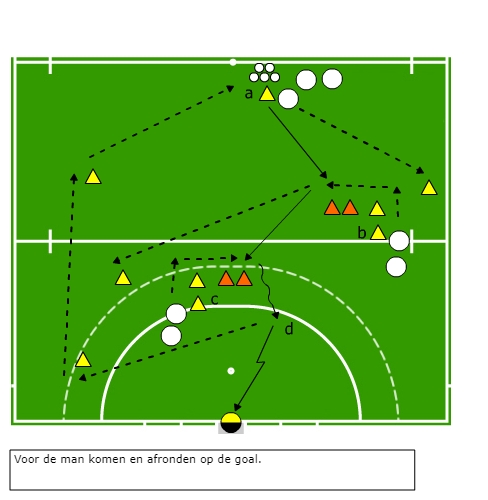
Variations:
- By removing one station, you can make the exercise smaller, requiring fewer players.
- The position from which the player who passes runs in front of the man starts can be changed. You can e.g. move point B more to the inside of the play area, making the direction of play different.
- You can also create an extra station near the goal for someone who is about to tip in Please note that you will need several players for this.
Points of attention:
- When floating, the ball is attached to the stick. This makes it almost impossible to take the ball away without committing a foul.
- When offering the ball, you have to make yourself wide so you can get between the ball and the defender
- Starting the run can be difficult to time, so pay extra attention to this
- The passes should be made in front of the orange cones, so that you are clearly running in front of the man
Passing in the run and finishing on goal
Objective:
Being able to combine, run with and without the ball, turn open, pass and finish on goal.
Set-up:
For the exercise at least 2 participants are active. When you also work with a goalkeeper, a third person is active.
- Player 1 has no ball and starts running from point A to point B.
- Player 2 stands on point E and stays there during the exercise. Player 2 plays the ball to player 1 in the run.
- When player 1 arrives at point B, he plays the ball back to player 2 and continues to point C.
- Player 2 plays the ball to point C so that player 1 can take it there.
- Player 1 turns inside and walks to the head of the circle.
- At point D, player 1 rounds the goal and runs out the exercise on the right side so he can run around point C and take over player 2's spot.
- After handing off player 2's final pass, he runs to point A and closes in at the back.
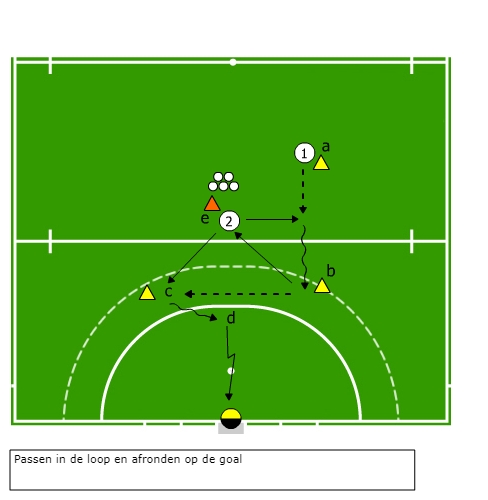
Variations:
- At point B, instead of passing the ball directly to player 2, player 1 can do a Swivel. In this way the player learns to put his body between the ball and the opponent.
- Player 2 can also pass to player 1 in the run from point B to point C. This trains you even more on passing and taking on in the run.
- The whole exercise can also be done in mirror image.
- Instead of one player on point E you can also have two different players make the pass. In that case, after the first pass, player 2 runs through and another player takes the ball and passes it to point C.
- If player 1 is fast enough, player 2 can also bounce the ball from point E to point C. This increases the difficulty by increasing the speed and adding the bounce.







